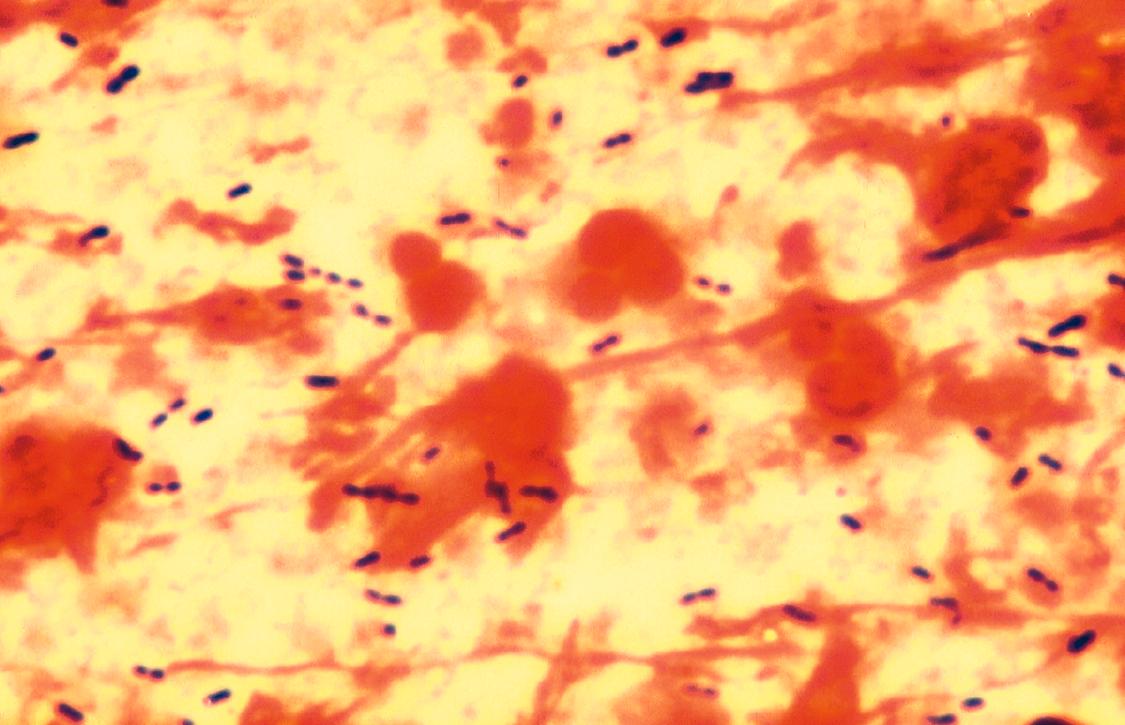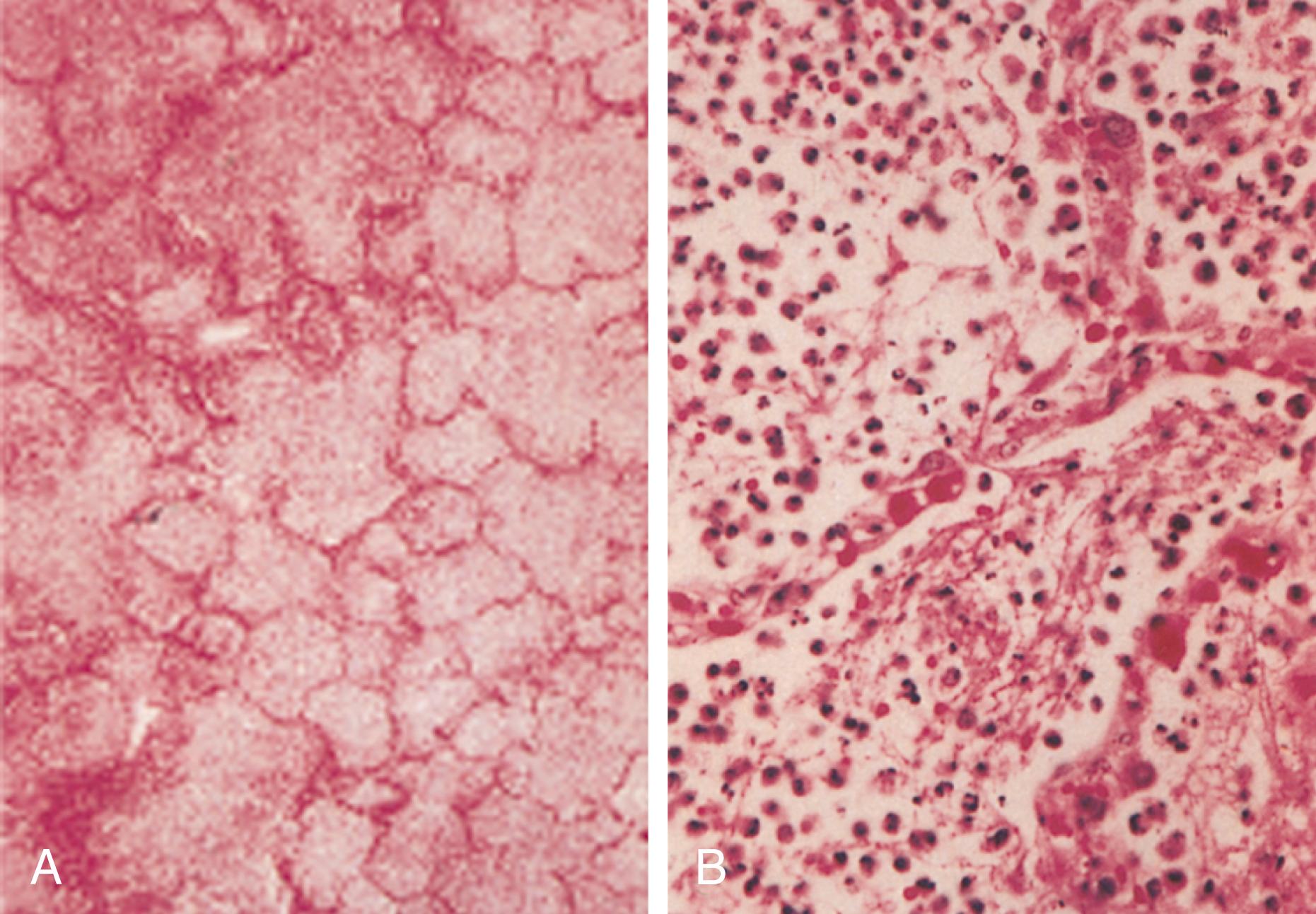Physical Address
304 North Cardinal St.
Dorchester Center, MA 02124
Streptococcus pneumoniae ( S. pneumoniae ) is a significant human bacterial pathogen and a major cause of community-associated bacterial infections. It is the most common bacterial cause of community acquired pneumonia (pneumococcal pneumonia; Chapter 85 ), sinusitis ( Chapter 394 ), and bacterial meningitis ( Chapter 381 ). Despite the availability of an effective vaccine, the burden of pneumococcal pneumonia remains high, particularly in older adults and in patients with underlying comorbid conditions.
S. pneumoniae (pneumococci) are lancet-shaped, encapsulated, gram-positive cocci. The cells are 0.5 to 1.2 µm in size and usually arranged end to end in pairs—often referred to as diplococci ( Fig. 268-1 ). Colonies appear α-hemolytic, demonstrate fastidious growth, and require catalase (e.g., blood) to grow on agar plates. The major virulence factor is a polysaccharide capsule that covers the organism and inhibits phagocytosis. Strains of pneumococci are classified according to the type of capsule, of which there are 100 known serotypes. Most S. pneumoniae serotypes have been shown to cause disease, but only a minority of serotypes produce the majority of pneumococcal infections. However, serotype patterns are slowly changing, in part because of the widespread use of polyvalent vaccine. Strains of S. pneumoniae can occasionally change capsular type via exchanging genes between different serotypes involved in capsule synthesis. In addition, genetic mutations or deletions can result in emergence of nonencapsulated strains. Such strains are less virulent but can be associated with noninvasive infection (e.g., conjunctivitis or otitis) and less commonly pneumonia. Another significant virulence factor, pneumolysin, is a cytolysin that causes damage to host cells and interferes with host immunity.

Each year in the United States, pneumococcal disease accounts for a substantial number of cases of invasive and noninvasive disease. Invasive pneumococcal disease includes cases with isolation of S. pneumoniae from normally sterile sites (e.g., blood, cerebrospinal fluid).
S. pneumoniae is the leading cause of mortality due to lower respiratory tract infections globally and causes approximately 1.2 million deaths each year. In 2020, the rate of invasive pneumococcal disease (mostly due to bacterial pneumonia) in the United States was 9.6/100,000 population, with a death rate of 1.06/100,000, and these rates are similar in Europe. The incidence of pneumococcal pneumonia declined by about 30% in industrialized countries during the severe acute respiratory syndrome coronavirus-2 (SARS-CoV-2) pandemic.
The widespread use of pneumococcal vaccines, especially the pneumococcal conjugate vaccine (PCV13), has reduced the incidence of pneumococcal infections, but the emergence of non-PCV13 serotypes has resulted in an increase back to or close to prevaccine levels. Furthermore, the number of cases is expected to increase as the population of elderly individuals increases.
S. pneumoniae , which remains the most common cause of community-acquired pneumonia ( Chapter 85 ), is isolated by culture in only 5 to 15% of cases in the United States, but quantitative molecular data indicate that the true rate is probably about 30%. Pneumococcal pneumonia is associated with bacteremia in approximately 10 to 30% of cases.
About 5 to 10% of patients with pneumococcal pneumonia will die, and the death rate is higher in patients requiring hospitalization or who are age 65 years and older. Fewer patients will develop pneumococcal meningitis ( Chapter 381 ), but the mortality rate for this infection is much higher.
Risk factors for pneumococcal pneumonia include smoking ( Chapter 363 ); asthma ( Chapter 75 ); alcohol use disorder ( Chapter 364 ); underlying chronic lung ( Chapters 76 , 78 , and 80 ) or heart disease ( Chapter 46 ); diabetes ( Chapter 210 ); cirrhosis ( Chapter 139 ); renal insufficiency ( Chapter 116 ); dementia ( Chapter 371 ); malnutrition ( Chapter 198 ); sickle cell anemia ( Chapter 149 ); immunocompromise, including HIV infection ( Chapter 358 ); intravenous drug use ( Chapter 365 ); and homelessness. Prior or co-infection with a respiratory virus, especially influenza ( Chapter 332 ), is also a risk factor for S. pneumoniae . SARS-CoV-2 infection ( Chapter 336 ) can similarly reduce host defenses of the respiratory tract against S. pneumoniae . ,
S. pneumoniae is an exclusively human pathogen and is predominantly spread from direct person-to-person contact via airborne droplets. The spread of the organism is influenced by such factors as crowding, especially during the winter and in early spring when respiratory diseases are more prevalent. After transmission, the organism commonly colonizes the nasopharynx, from which it can spread to the lungs, paranasal sinuses, or middle ear. It can also be transported in the blood to distal sites such as the brain, heart, and joints. Colonization in the pharynx is mediated by the binding of the bacteria to epithelial cells by means of surface protein adhesins. Strains with a smaller capsular size have increased exposure of adhesins, which correlates with enhanced colonization. Pneumococci may be isolated from the nasopharynx of 5 to 50% of healthy persons, depending on the population and setting, and carriage is most common in winter and early spring, especially in school-aged children.
From the nasopharynx, pneumococci can migrate to the lower respiratory tract by microaspiration of oropharyngeal secretions containing the organism. Hematogenous spread from a distant infected site, direct spread from a contiguous focus, and macroaspiration are other mechanisms whereby S. pneumoniae may gain access to the lung.
The disease manifestations of S. pneumoniae are caused primarily by the host response to infection rather than the production of organism-associated toxins. The development of pneumococcal pneumonia becomes more likely when a more virulent strain or the amount of aspirated pneumococci overwhelms the host defense system in the respiratory tract ( Fig. 268-2 ). Innate host defenses, which reduce development of pneumonia, include the physiologic removal of bacteria, which become enveloped within mucus and eliminated by the action of ciliated epithelial cells of the respiratory tract. Secretory IgA facilitates the trapping of bacteria in mucus by binding bacteria to mucin; secretory IgA protease produced by S. pneumoniae can overcome this host defense. In addition, the polysaccharide capsule plays a role in reducing attachment to airway mucus.

S. pneumoniae resists phagocytosis in part because of the antiphagocytic protection by its capsule. Antibodies directed against the specific type of capsular polysaccharide protect against disease caused by that specific strain by facilitating phagocytosis of the organism and killing of the bacteria. Patients with abnormalities related to antibody production (e.g., asplenia, immunoglobulin deficiencies, multiple myeloma, chronic lymphocytic leukemia) or to phagocytic function (e.g., chronic granulomatous disease, hyperimmunoglobulin E syndrome, myeloperoxidase deficiency, Chediak-Higashi syndrome) are at higher risk for pneumococcal pneumonia and for worse outcomes when infection occurs.
Become a Clinical Tree membership for Full access and enjoy Unlimited articles
If you are a member. Log in here